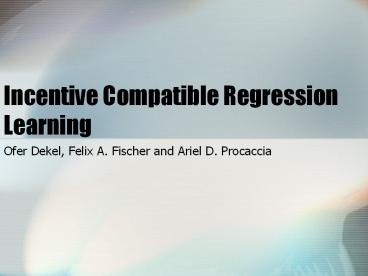Incentive%20Compatible%20Regression%20Learning - PowerPoint PPT Presentation
Title:
Incentive%20Compatible%20Regression%20Learning
Description:
... Compatible Regression Learning. Ofer Dekel, Felix A. Fischer and Ariel D. Procaccia ... Ranking function assigns real value to every (query,answer) ... – PowerPoint PPT presentation
Number of Views:25
Avg rating:3.0/5.0
Title: Incentive%20Compatible%20Regression%20Learning
1
Incentive Compatible Regression Learning
- Ofer Dekel, Felix A. Fischer and Ariel D.
Procaccia
2
Lecture Outline
Model
Degenerate
Uniform
General
- Until now applications of learning to game
theory. Now merge. - The model
- Motivation
- The learning game
- Three levels of generality
- Distributions which are degenerate at one point
- Uniform distributions
- The general setting
3
Motivation
Model
Degenerate
Uniform
General
- Internet search company improve performance by
learning ranking function from examples. - Ranking function assigns real value to every
(query,answer). - Employ experts to evaluate examples.
- Different experts may have diff. interests and
diff. ideas of good output. - Conflict ? Manipulation ? Bias in training set.
4
Jaguar vs. Panthera Onca
Model
Degenerate
Uniform
General
(Jaguar, jaguar.com)
5
Regression Learning
Model
Degenerate
Uniform
General
- Input space XRk ((query,answer) pairs).
- Function class FX?R (ranking functions).
- Target function oX?R.
- Distribution ? over X.
- Loss function l (a,b).
- Abs. loss l (a,b)a-b.
- Squared loss l (a,b)(a-b)2.
- Learning process
- Given Training set S(xi,o(xi)), i1,...,m, xi
sampled from ?. - R(h)Ex??l (h(x),o(x)).
- Find h?F to minimize R(h).
6
Our Setting
Model
Degenerate
Uniform
General
- Input space XRk ((query,answer) pairs).
- Function class F (ranking functions).
- Set of players N1,...,n (experts).
- Target functions oiX?R.
- Distributions ?i over X.
- Training set?
7
The Learning Game
Model
Degenerate
Uniform
General
- ?i controls xij, j1,...,m, sampled w.r.t. ?i
(common knowledge). - Private info of i oi(xij)yij, j1,...,m.
- Strategies of i yij, j1,...,m.
- h is obtained by learning S(xij,yij)
- Cost of i Ri(h)Ex??i l (h(x),oi(x)).
- Goal Social Welfare (please avg. player).
8
Example The learning game with ERM
Model
Degenerate
Uniform
General
- Parameters XR, FConstant Functions, l
(a,b)a-b, N1,2, o1(x)1, o2(x)2,
?1?2uniform dist on 0,1000. - Learning algorithm Empirical Risk Minimization
(ERM) - Minimize R(h,S)1/S ? ?(x,y)?Sl (h(x),y).
2
1
9
Degenerate Distributions ERM with abs. loss
Model
Degenerate
Uniform
General
- The Game
- Players N1,...n
- ?i degenerate at xi.
- ?i controls xi.
- Private info of i oi(xi)yi.
- Strategies of i yi.
- Cost of i Ri(h) l (h(xi),yi).
- Theorem If l absolute loss and F is convex.
Then ERM is group incentive compatible.
10
ERM with superlinear loss
Model
Degenerate
Uniform
General
- Theorem l is superlinear, F is convex, F?2,
F is not full on x1,...,xn. Then ?y1,...,yn
such that there is incentive to lie. - Example XR, FConstant Functions, l
(a,b)(a-b)2, N1,2.
11
Uniform dist. over samples
Model
Degenerate
Uniform
General
- The Game
- Players N1,...n
- ?i Discrete uniform on xi1,...,xim
- ?i controls xij, j1,...,m
- Private info of i oi(xij)yij.
- Strategies of i yij, j1,...,m.
- Cost of i
Ri(h) Ri(h,S) 1/m??jl (h(xij),yij).
12
ERM with abs. loss is not IC
Model
Degenerate
Uniform
General
1
0
13
VCG to the Rescue
Model
Degenerate
Uniform
General
- Use ERM.
- Each player pays ?j?iRj(h,S).
- Each players total cost is
Ri(h,S)?j?iRj(h,S) ?jRj(h,S). - Truthful for any loss function.
- VCG has many faults
- Not group incentive compatible.
- Payments problematic in practice.
- Would like (group) IC mechanisms w/o payments.
14
Mechanisms w/o Payments
Model
Degenerate
Uniform
General
- Absolute loss.
- ?-approximation mechanism gives an
?-approximation of the social welfare. - Theorem (upper bound) There exists a group IC
3-approx mechanism for constant functions over Rk
and homogeneous linear functions over R. - Theorem (lower bound) There is no IC
(3-?)-approx mechanism for constant/hom. lin.
functions over Rk. - Conjecture There is no IC mechanism with bounded
approx. ratio for hom. lin. functions over Rk,
k?2.
15
Proof of Lower Bound
Model
Degenerate
Uniform
General
3
2
1
0
1-
2-
3-
16
Proof of Lower Bound
Model
Degenerate
Uniform
General
3
2
1
0
1-
2-
k
k-1
k
k-1
3-
17
Generalization
Model
Degenerate
Uniform
General
- Theorem If ?f,
- (1) ?i, Ri(f,S)-Ri(f) ? ?/2
- (2) R(f,S)-1/n??i Ri(f) ? ?/2
- Then
- (Group) IC in uniform ? ?-(group) IC in general.
- ?-approx in uniform ? ?-approx up to additive ?
in general. - If F has bounded complexity, m?(log(1/?)/?),
then cond. (1) holds with prob. 1-?. - Cond. (2) is obtained if (1) occurs for all i.
Taking ?/n adds factor of logn.
18
Discussion
Model
Degenerate
Uniform
General
- Given m large enough, with prob. 1-? VCG is
?-truthful. This holds for any loss function. - Given m large enough, abs loss, ?mechanism w/o
payments which is ?-group IC and 3-approx for
constant functions and hom. lin. functions. - Most important direction for future work
extending to other models of learning, such as
classification.

